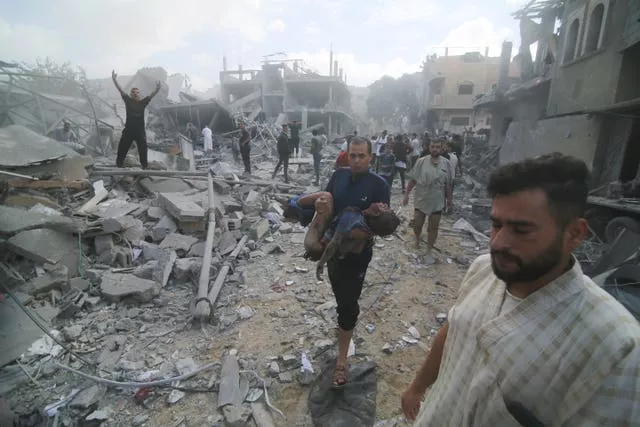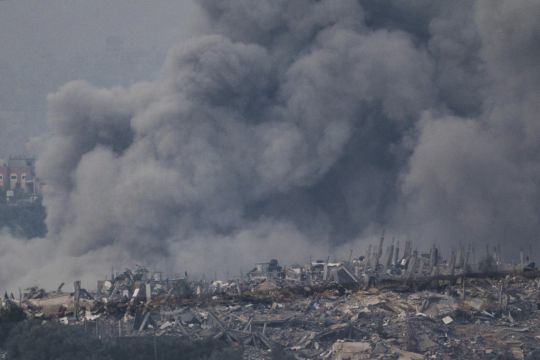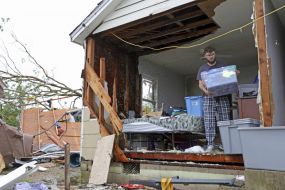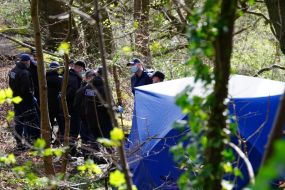Israeli forces struck the southern Gaza town of Rafah twice overnight, residents said, sowing fear in one of the last places where civilians could seek refuge after Israel widened its offensive against Hamas to areas already packed with displaced people.
United Nations officials say there are no safe places in Gaza.
Heavy fighting in and around the southern city of Khan Younis has displaced tens of thousands of people in a territory where more than 80% of the population have already fled their homes, and cut most of Gaza off from deliveries of food, water and other vital aid.
Two months into the war, the grinding offensive has set off renewed alarms internationally, with UN secretary-general Antonio Guterres using a rarely exercised power to warn the Security Council of an impending “humanitarian catastrophe” and urging members to demand a ceasefire.

The United States has called on Israel to limit civilian deaths and displacement, saying too many Palestinians were killed when it obliterated much of Gaza City and the north.
But President Joe Biden’s administration, which has pledged unwavering support for Israel, appeared likely to block any such UN effort to halt the fighting.
Israel says it must crush Hamas’s military capabilities and remove it from power following the October 7 attack that ignited the war.
Troops have pushed into Khan Younis, Gaza’s second-largest city, which Israeli officials have portrayed as Hamas’s centre of gravity – something they previously said was in Gaza City and its Shifa Hospital.
Israel has ordered the evacuation of some two dozen southern neighbourhoods, rather than the entire region as it did in the north, which the military says shows increased concern for civilians.
But the areas where Palestinians can seek safety are rapidly receding.
With northern and central Gaza largely isolated and cut off from aid, Palestinians are heading south to Rafah and other areas along the border with Egypt, where family homes are packed tight and makeshift shelters are overflowing.

Even there, safety has proven elusive, as Israel continues to strike what it says are Hamas targets across the coastal enclave.
A strike late on Wednesday levelled a home in Rafah, sending a wave of wounded streaming into a nearby hospital.
Eyad al-Hobi, who witnessed the attack, said around 20 people were killed, including women and children.
Another house was hit early on Thursday, residents said.
“We live in fear every moment, for our children, ourselves, our families,” said Dalia Abu Samhadaneh, now living in Rafah with her family after fleeing Khan Younis.
“We live with the anxiety of expulsion.”
The military meanwhile accused militants of firing rockets from open areas near Rafah in the humanitarian zone.
It released footage of a strike on Wednesday on what it said were launchers positioned outside the town and a few hundred metres from a UN warehouse.
“The international community has a responsibility to use all its influence to prevent further escalation and end this crisis.”
- @antonioguterres invokes Article 99 of UN Charter, urging Security Council to act to avert a humanitarian catastrophe in Gaza. https://t.co/vOFMPATuao pic.twitter.com/7kChQjBXhi— United Nations (@UN) December 6, 2023
The UN said some 1.87 million people – more than 80% of the population of 2.3 million – have already fled their homes, many of them displaced multiple times.
Israel’s campaign has killed more than 17,100 people in Gaza – 70% of them women and children – and wounded more than 46,000, according to the territory’s Health Ministry, which says many others are trapped under rubble. The ministry does not differentiate between civilian and combatant deaths.
Doctors Without Borders, the international aid group, said another 115 bodies arrived at the Al-Aqsa Martyrs Hospital in the central town of Deir al-Balah in a 24-hour period.
“The hospital is full, the morgue is full,” the group said on X, formerly known as Twitter.
The military said on Thursday that it struck dozens of militant targets in Khan Younis, including a tunnel shaft from which fighters had launched an attack. It said two of the attackers were killed.
In the afternoon, a heavy strike near a main intersection in the centre of Khan Younis left a large field of rubble, and survivors said many people were believed to be buried underneath.
Rescuers pulled bloodied women and children from the shells of nearby buildings gutted in the blast and a truck rushed off carrying several wounded men.
Hamas and other militants killed about 1,200 people, mostly civilians, in the October 7 attack that triggered the war, and took some 240 people hostage. An estimated 138 hostages remain in Gaza, mostly soldiers and civilian men, after 105 were freed during a ceasefire in late November.
WFP urgently calls for a humanitarian ceasefire in #Gaza.
The recent pause allowed us to reach 250,000 people, but the distribution of aid is now almost impossible and endangers the lives of humanitarian workers.
Above all, it is a disaster for the civilian population of Gaza.— World Food Programme (@WFP) December 6, 2023
Heavy fighting is also still under way in the Jabaliya refugee camp in northern Gaza, even after two months of heavy bombardment and encirclement by ground troops. The military said troops raided a militant compound, killing a number of fighters and uncovering a network of tunnels.
It was not immediately possible to confirm the latest reports from the battlefield.
Israel blames the high civilian death toll on Hamas, accusing it of using civilians as human shields when the militants operate in residential areas. But Israel has not given detailed accounts of its individual strikes, some of which have levelled entire city blocks.
The military says 87 of its soldiers have been killed in the Gaza ground offensive. It also says some 5,000 militants have been killed, without saying how it arrived at its count.
Tens of thousands of people have fled from Khan Younis and other areas to Rafah, on Gaza’s southern border with Egypt, the UN said, adding that five UN schools where displaced people were sheltering in Khan Younis were completely evacuated after direct orders from the Israeli military.
Rafah, normally home to around 280,000 people, is already hosting more than 470,000 who fled from other parts of Gaza.
On the other side of the border, Egypt has deployed thousands of troops and erected earthen barriers to prevent any mass influx of refugees. It says an influx would undermine its decades-old peace treaty with Israel, and it doubts Israel will let them back into Gaza.

For days now, aid groups have been able to distribute supplies only in and around Rafah, and mainly just flour and water, the UN’s humanitarian aid office said. Access farther north has been cut off by fighting and Israeli forces closing roads.
The World Food Programme said a “catastrophic hunger crisis” threatens to “overwhelm the civilian population”.
Gaza has been without electricity since the first week of the war, and hospitals and water treatment plants have been forced to shut down due to a lack of fuel to operate generators. Israel allows a trickle of aid from Egypt but has greatly restricted imports of fuel, saying Hamas diverts it for military purposes.
Meanwhile, Israeli Prime Minister Benjamin Netanyahu threatened to flatten parts of Lebanon if the Hezbollah militant group escalates its attacks on Israeli targets.
Mr Netanyahu delivered the threat on Thursday during a visit to a military base in northern Israel. The visit came as a 54-year-old Israeli farmer was killed by an anti-tank missile fired from Lebanon.
Mr Netanyahu said images of destruction in the war-ravaged Gaza Strip provide a glimpse of what could lie ahead for Lebanon.

“If Hezbollah chooses to launch an all-out war, then it will single-handedly turn Beirut and southern Lebanon, not far from here, to Gaza and Khan Younis,” he said.
The Israeli military said it struck Hezbollah infrastructure in response to rocket fire on Thursday.
The rocket fire — and Israel’s counter-attacks in Lebanon — have led thousands of Israeli and Lebanese civilians who reside near the border to evacuate.







